Bat Trang ceramics village, located on the left bank of the Red River and around 13 kilometers southeast of the capital city of Hanoi, has gained widespread recognition as a renowned tourist destination for its exquisite pottery and porcelain products.
The establishment and growth of numerous traditional craft villages, including Bat Trang ceramics village, can be attributed to the founding of Thang Long capital city, known as Hanoi between the 11th and 14th centuries.
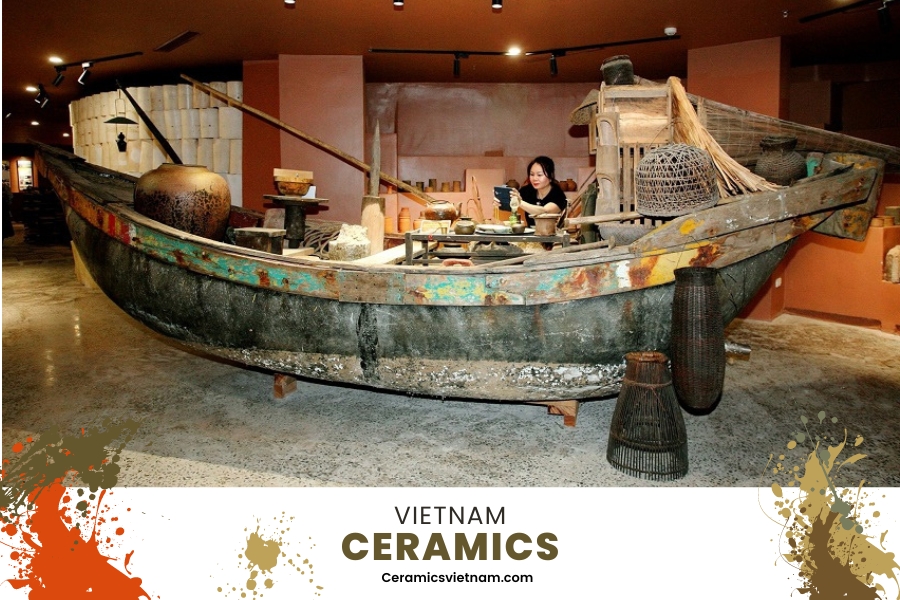
The boats and early pottery used by the people of An Mer District, Ninh Binh Province to settle in Bazhuang along the Red River upstream. Photo: Tran Mai Anh
According to Bat Trang villagers, their village was founded during the Ly dynasty when King Ly Thai To relocated the capital from Hoa Lu in Ninh Binh province to Thang Long in 1010. A group of traders and craftsmen, including some from Bo Bat ceramics village in Yen Mo district of Ninh Binh province, followed him and settled in the new capital. The potters discovered several mounds of white clay, which is the key material for making ceramics, in an area on the outskirts of the new capital, now known as Bat Trang village. They decided to establish pottery kilns there, and the village quickly gained a reputation for its exceptional craftsmanship and quality materials, eventually becoming a leading ceramics center in the country.
The Bat Trang ceramics village produces a wide range of products, including crockery, decorative items, and ceremonial objects. However, two defining features that distinguish Bat Trang pottery from products of other traditional ceramics villages are embossed decoration and ivory-white crackle glaze.
The traditional technique used by Bat Trang potters involves four steps: raw material preparation, clay shaping, decoration and glazing, and firing.
Preparing raw materials
The first step in making ceramic products involves preparing the raw materials, which are clay and glaze.
Initially, Bat Trang potters used locally sourced clay to create their pottery items, but as the local sources of white clay became depleted, they had to search for alternative sources from neighboring areas. They sailed along the Red River and purchased clay from different localities, such as Phung Cong and Dan Nhiem villages in Van Giang district of Hung Yen province, Van Loc and Co Dien villages in Dong Anh district of Hanoi, and the villages of Tu Lac and Bich Nhoi in Kinh Mon district and Truc Thon and Ho Lao in Chi Linh district of Hai Duong province.
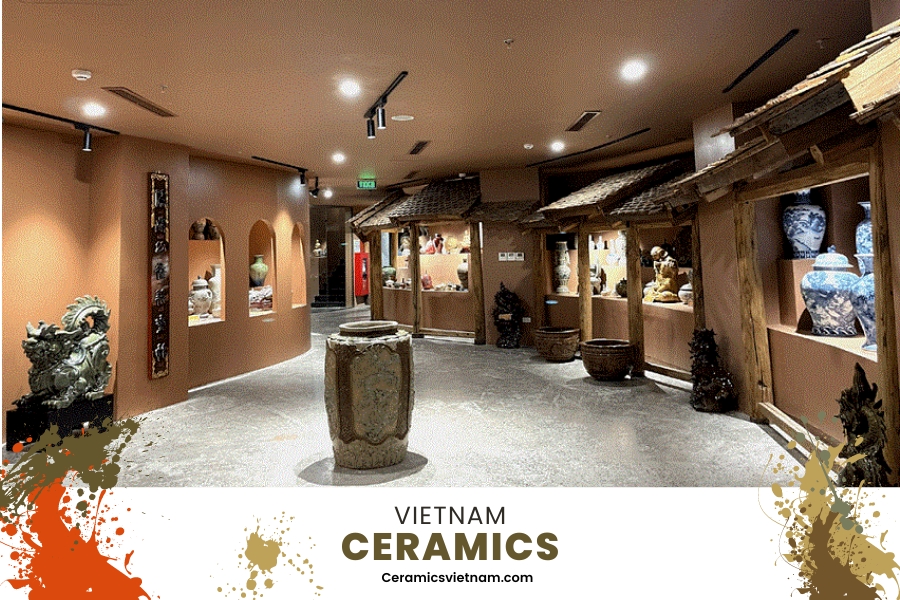
A room in the Bat Trang Ceramics Museum.
To prepare the clay for use, potters must first remove any impurities from the raw materials and blend them using a suitable method. Bat Trang craftsmen use four water tanks for the process of earth treatment. The raw clay is soaked in water for three or four months in the first tank, which is called the stirring ark and is placed in the highest position. After this time, the earth decomposes and dissolves in water. The slurry is then drained to the second tank, called the sedimentation ark or filter ark, which is positioned next to the first one but at a lower level. In the second tank, the clay particles slowly deposit while impurities, mainly organic substances, float to the surface and are removed. The deposited material is then transferred to the third tank, called the drying ark, where it is left for three to four days. Finally, it is poured into the last tank, called the fermenting ark, where iron oxide and other impurities are eliminated during fermentation. During the earth treatment process, kaolin or non-plastics may be added to prevent cracks during the drying or firing process.
The process of earth treatment is relatively straightforward, but the creation of glazes is considered a closely guarded secret that is passed down from generation to generation within the village and each family.
Initially, glaze ingredients are ground, screened, blended, and then mixed with water to create a slurry. Potters then pour the solution into a glaze tank and allow it to sit for a couple of days until the glazes, which are colloids suspended in the water, settle at the bottom and the water becomes clear.
Traditional Bat Trang ceramics typically feature five types of glazes, with ash glaze being the most commonly used. This type of glaze is created using white clay, lime, and rice husk ash. Brown glaze is produced by adding iron oxide and manganese oxide to the ash glaze, while crackle glaze is made using lime, rice husk ash, and light pink kaolin. However, despite using the same ingredients, each artisan has their own secret recipe for creating unique glazes.
Shaping clay
In order to shape the clay, Bat Trang potters use a technique called throwing to create circular pieces such as plates, cups, and bowls using foot-operated wheels. The process begins by taking a thoroughly wedged lump of clay, rolling it into a coil, and placing it centrally on the wheel. As the wheel turns, the potter uses only their hands to squeeze and shape the clay piece. They may also use a pottery rib to remove excess clay from the piece and a long piece of wire to remove it while the wheel is turning slowly.

Spirit of Place: Divine Inspiration for Pottery
After the greenware is removed from the wheel, it is left to dry until it reaches a leather-hard state. In the past, Bat Trang potters would place the greenware on shelves to dry in cool places. However, nowadays, the shaped clay pieces are placed into kilns where the temperature is gradually increased to evaporate the moisture. Once the greenware has reached a leather-hard state, the craftsmen have the final opportunity to make any necessary adjustments to the items. This can include trimming the base edge to ensure there are no burrs or brittle edges, carving decorative patterns, adding separate parts such as handles or spouts, polishing the surface, drilling holes, or removing the seam left by the mold.
Decorating and glazing
When it comes to decorating their pottery items, Bat Trang potters use various techniques. They may use color or colored glazes to create rings around the base or topmost edge of the products, known as foot-rim and mouth-rim, respectively. They also apply soil to certain areas on the products and prune them to create shapes or impress patterns on the body of the items, known as embossing. In addition, brushes are used to draw decorative patterns on the products. Glaze is then applied to the topmost edge of the products, allowing the glazing layer to fuse naturally with the ceramic body during the gloss firing process.
Once decorated, the pottery ware can be fired at a low temperature and then glazed, or glazed before being fired. However, Bat Trang potters prefer to apply glazes directly to their products after wiping away dust. They typically apply glaze by pouring it for the inside, dipping it for the coating, or combining the two methods. For larger products, glaze spraying is used. Any defects in the glaze are removed from the products before they are filled in the kilns.
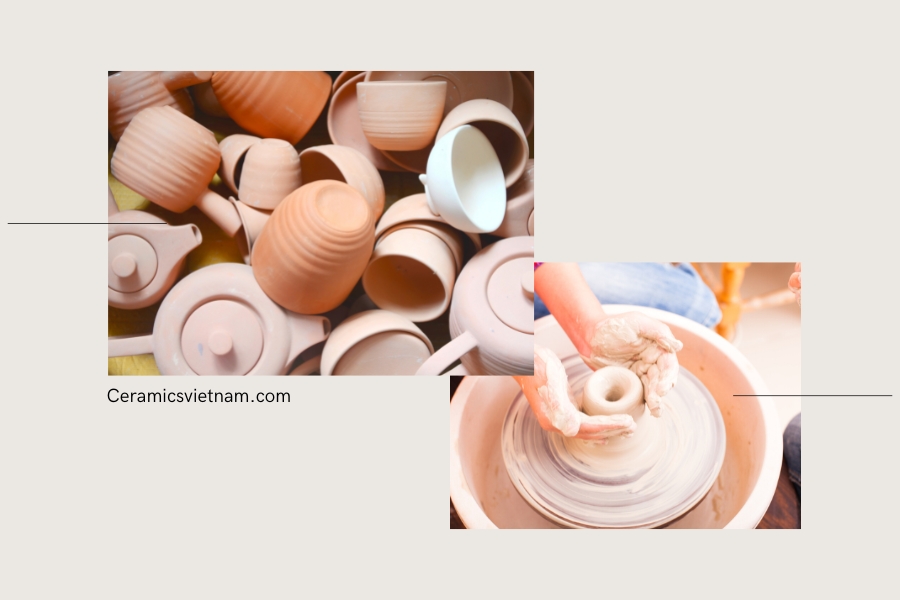
Bát Tràng Pottery Village
Firing
Firing is a crucial process that transforms clay into ceramics and raw works of art into finished masterpieces. The way in which a ceramic piece is fired has a significant impact on its final appearance.
Historically, Bat Trang potters used wood or dust coal-fueled kilns to fire their products. There were several types of kilns with different structures, each requiring a unique firing technique. For example, frog-shaped kilns, one of the oldest kilns used in Bat Trang village, involved carefully stacking glazed items on top of one another, lining them up from the center to the gate of the kiln. The kilns’ design prevented the outside temperature from rising too high, even when the inside temperature reached its maximum level of up to 1,300 degrees Celsius.
Before kindling the fire, the oldest craftsman would light three incense sticks and hold a sacrificed dog or rooster while walking around the kiln to pray to the Jade Emperor and fire god for a successful batch of ceramic products.
A wood kiln firing typically takes three days and three nights from start to finish. During the first three days and two nights, the fire is lit at the main entrance chamber of the kiln where the potter enters or firewood is fed. On the third night, firing continues at six horizontal rows of stoke holes and eight vertical rows of stoke holes on the arch of the kiln, as well as two stoke holes of the chimney chamber. The temperature inside the kiln gradually increases to its highest level before being slowly reduced as the pottery reaches maturity. The kiln is left for three days before the finished ceramic products are taken out.
Reference
Bat Trang Ceramics Village
Bat Trang Ceramics Village is a small village located on the left bank of the Red River, around 13 kilometers southeast of the capital city of Hanoi, Vietnam. This village has been recognized as one of the country’s most famous tourist destinations, renowned for its well-known pottery and porcelain products. With a history that dates back more than a thousand years, Bat Trang Ceramics Village is an integral part of Vietnam’s cultural heritage and a testament to the country’s rich history and artistic tradition.
The founding of Thang Long capital city, now known as Hanoi, during the 11th to 14th century had a significant economic impact on the establishment and development of many traditional craft villages, including Bat Trang Ceramics Village. The villagers believe that their village was established during the Ly dynasty, when King Ly Thai To relocated the capital city from Hoa Lu in the northern province of Ninh Binh to Thang Long in 1010. A number of traders and craftsmen followed the king to settle down in the new capital, and among them were some from Bo Bat Ceramics Village in Yen Mo district of Ninh Binh province. These potters found several mounds of white clay, the essential material for making ceramic products, in an outskirt area of the new capital city, which is now Bat Trang Village, and decided to build pottery kilns there. Thanks to exquisite workmanship and abundant sources of high-quality materials, the village gradually built up its reputation and became a well-known ceramics center of the country.

Ceramics in Vietnam: Making ceramics in Bat Trang traditional craft village
Bat Trang Ceramics Village is famous for its diverse range of pottery products that are both functional and decorative. The village’s artisans produce everything from crockery and decorative items to ceremonial objects, with each piece being unique and crafted with great care and attention to detail. The village’s most distinguishing features are its embossed decoration and ivory-white crackle glaze, which distinguish Bat Trang pottery from products of other traditional ceramics villages.
To create their pottery products, Bat Trang potters use a traditional four-step process that includes preparing raw materials, shaping clay, decorating and glazing, and firing. Raw materials such as clay and glaze are essential to the process, and the potters have to remove impurities from the raw materials and apply a suitable method of blending. The clay is then shaped using a technique called throwing, in which a lump of thoroughly wedged clay is rolled into a coil and placed centrally on the wheel. The potter then uses their two hands to squeeze and shape the clay piece as the wheel turns.
Once shaped, the pottery items are left to dry until they reach a leather-hard state, after which the artisans apply various decorating techniques such as coloring or colored glazes to create rings around the base or topmost edge of the products, known as foot-rim and mouth-rim, respectively. They may also apply soil to certain areas on the products and prune them to create shapes or impress patterns on the body of the items, known as embossing. Glaze is then applied to the topmost edge of the products, allowing the glazing layer to fuse naturally with the ceramic body during the gloss firing process.
Firing is a crucial process that transforms clay into ceramics and raw works of art into finished masterpieces. Historically, Bat Trang potters used wood or dust coal-fueled kilns to fire their products. There were several types of kilns with different structures, each requiring a unique firing technique. Before kindling the fire, the oldest craftsman would light three incense sticks and hold a sacrificed dog or rooster while walking around the kiln to pray to the Jade Emperor and fire god for a successful batch of ceramic products.
Today, Bat Trang Ceramics Village uses modern gas kilns to fire their products, although some artisans still use traditional wood-fired kilns to maintain the village’s artistic tradition. The firing process can take up to three days and three nights, during which the kiln’s temperature gradually increases to its highest level before being slowly reduced as the pottery reaches maturity. The kiln is left for three days before the finished ceramic products are taken out.
Bat Trang Ceramics Village has a strong reputation both domestically and internationally for its artistic and cultural heritage. The village’s pottery products have won numerous awards and have been exported to many countries around the world. The village also offers visitors the opportunity to experience the traditional pottery-making process, with several workshops offering hands-on pottery classes and guided tours.
In addition to its pottery products, Bat Trang Ceramics Village is also known for its traditional architecture, including old houses and temples that have stood the test of time. The village’s narrow streets are lined with pottery shops and workshops, offering a unique shopping experience for visitors who are interested in taking home a piece of Bat Trang’s rich cultural heritage.
Bat Trang Ceramics Village has been recognized as a national cultural heritage site by the Vietnamese government and is a must-visit destination for anyone interested in Vietnam’s history and artistic tradition. The village’s rich cultural heritage and artistic tradition continue to attract visitors from around the world, making Bat Trang Ceramics Village a true gem of Vietnamese tourism.
Ceramics in Vietnam Today
Ceramics in Vietnam have a rich and varied history dating back over 2,000 years. The country’s geographical location at the crossroads of Southeast Asia and East Asia has made it an important trading hub throughout history, and its ceramics industry has flourished as a result.
In ancient times, Vietnamese ceramics were primarily produced in northern Vietnam, in the Red River Delta region, which was rich in clay deposits. The ceramics were made using traditional techniques and decorated with unique motifs that reflected the local culture and traditions. The ceramics industry continued to develop and thrive over the centuries, with significant contributions made by Chinese, Cham, and Khmer artisans who settled in Vietnam over time.
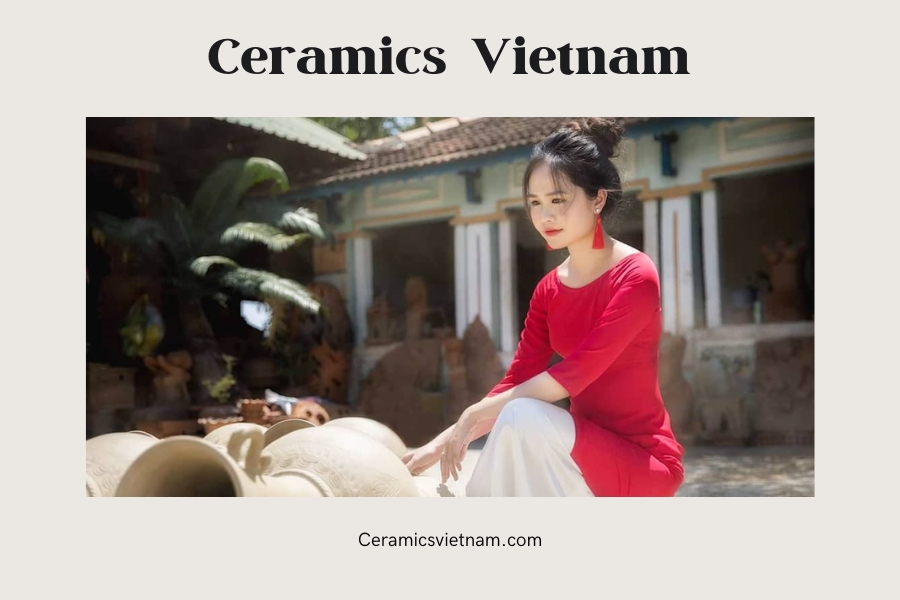
Bau Truc village (Binh Thuan)
During the French colonial period, from the late 19th century to the mid-20th century, Vietnamese ceramics experienced a period of decline due to the introduction of cheaper, mass-produced European ceramics. However, the industry revived in the post-colonial period, with a renewed emphasis on traditional techniques and motifs.
Today, ceramics in Vietnam are produced using both traditional and modern techniques. Many artisans continue to use traditional techniques, such as hand-building and wheel-throwing, while others use modern techniques such as slip-casting and press-molding. The materials used in Vietnam’s ceramics industry have also evolved over time, with contemporary ceramics being made from a variety of materials such as clay, porcelain, stoneware, and earthenware.
Vietnamese ceramics are known for their unique aesthetic, which blends traditional motifs and techniques with contemporary design. The country’s ceramics industry produces a wide range of products, from utilitarian items such as plates, bowls, and teapots, to decorative items such as vases, figurines, and lamps.
The ceramics industry in Vietnam is centered in several regions of the country, each with its unique style and tradition. The northern region, with its rich clay deposits and long history of ceramics production, is home to several famous ceramics villages, including Bat Trang and Phu Lang. These villages are known for their traditional techniques and motifs, such as Bat Trang’s ivory-white crackle glaze and Phu Lang’s black-glazed pottery.
The central region of Vietnam is home to the Cham people, who have a long history of ceramics production dating back over 2,000 years. Cham ceramics are known for their intricate designs and use of bright colors. The southern region of Vietnam is home to several ceramics villages, including Bien Hoa and Sa Dec, which are known for their modern and contemporary ceramics.
The ceramics industry in Vietnam has undergone significant changes in recent years, with a renewed focus on sustainability and eco-friendliness. Many artisans are turning to natural materials and environmentally friendly techniques to produce their ceramics, and there is a growing trend towards using recycled materials in the production process.
The Vietnamese government has also recognized the importance of the ceramics industry and has taken steps to promote and preserve traditional techniques and motifs. Several ceramics festivals and exhibitions are held throughout the year, showcasing the best of Vietnam’s ceramics industry and promoting the country’s cultural heritage.
In conclusion, the ceramics industry in Vietnam is a testament to the country’s rich cultural heritage and artistic tradition. The industry has evolved over the centuries, blending traditional techniques and motifs with contemporary design and materials. Today, the ceramics industry in Vietnam is thriving, with a renewed emphasis on sustainability and eco-friendliness. Whether you are a collector or simply interested in exploring Vietnam’s cultural heritage, the country’s ceramics industry offers a unique and fascinating glimpse into the country’s history and artistic tradition.
King Ly Thai To
King Ly Thai To, also known as Ly Cong Uan, was the founder and first emperor of the Ly Dynasty in Vietnam. He reigned from 1009 to 1028 and is widely regarded as one of Vietnam’s greatest monarchs. He is also known for his role in establishing the city of Thang Long, which would later become Hanoi, Vietnam’s capital city.
Ly Thai To was born in 974 in the province of Kinh Bac, in northern Vietnam. His family was part of the aristocracy, and he grew up with a strong sense of duty and responsibility. He was a talented military strategist and played a key role in the defense of Vietnam against the Chinese invaders.
In 1009, Ly Thai To became emperor of Vietnam, following a period of political turmoil and instability. He immediately set about consolidating his power and establishing his authority over the country. One of his first acts as emperor was to move the capital city from Hoa Lu, in the province of Ninh Binh, to Thang Long, which would later become Hanoi.
The decision to move the capital city was a strategic one, designed to strengthen the country’s defenses against potential invaders. Thang Long was located on the banks of the Red River, which provided a natural barrier against enemy forces. It was also strategically located between China and the rest of Southeast Asia, making it an ideal location for trade and commerce.
In addition to his military and strategic accomplishments, Ly Thai To was also a patron of the arts and culture. He is credited with the establishment of the Ly Dynasty’s unique artistic and cultural tradition, which blended Chinese and Vietnamese influences to create a distinct and vibrant style.
Ly Thai To was also a devout Buddhist and worked to promote the spread of Buddhism throughout Vietnam. He built several Buddhist temples and sponsored the translation of Buddhist texts into Vietnamese. He was a firm believer in the power of Buddhism to promote peace and prosperity and saw it as an important tool in unifying the country.
Ly Thai To died in 1028, at the age of 54. He was succeeded by his son, Ly Thai Tong, who continued his father’s policies and traditions. Today, Ly Thai To is remembered as one of Vietnam’s greatest monarchs, a visionary leader who played a key role in shaping the country’s history and culture.
His legacy lives on in many ways, including the establishment of Thang Long as Vietnam’s capital city and the development of the Ly Dynasty’s artistic and cultural traditions. His devotion to Buddhism and his belief in the power of culture and the arts to unify a nation continue to inspire and guide the Vietnamese people to this day.
In conclusion, King Ly Thai To was a visionary leader who played a key role in shaping Vietnam’s history and culture. His military and strategic accomplishments, his patronage of the arts and culture, and his devotion to Buddhism and belief in the power of culture to unify a nation are all part of his lasting legacy. He remains a beloved and revered figure in Vietnam to this day, a symbol of the country’s rich cultural heritage and its proud and independent spirit.
Thang Long capital city
Thang Long capital city was the political and cultural center of Vietnam during the Ly Dynasty (1010-1225) and the Tran Dynasty (1225-1400). Located in the Red River Delta region of northern Vietnam, Thang Long was an important commercial hub and a center of cultural exchange between Vietnam, China, and other neighboring countries.
Thang Long was established in 1010, when the emperor Ly Thai To moved the capital of Vietnam from Hoa Lu to the site of present-day Hanoi. The name Thang Long means “ascending dragon,” and it was chosen by Ly Thai To as a symbol of his hope for the prosperity and power of the new capital.
Under the Ly Dynasty, Thang Long grew rapidly, becoming a center of trade, culture, and learning. The dynasty’s patronage of Buddhism and Confucianism led to the construction of many temples, pagodas, and other religious structures throughout the city. Thang Long also became a center of education, with the establishment of several schools and academies, including the famous Quoc Tu Giam, Vietnam’s first national university.
During the Tran Dynasty, Thang Long continued to prosper and expand. The dynasty’s military and economic power grew, as it established trade relationships with China, Korea, and other countries in the region. The city’s architecture and infrastructure also developed, with the construction of new palaces, temples, and markets.
Throughout its history, Thang Long was known for its vibrant culture, with music, dance, and theater playing a central role in daily life. The city was also famous for its cuisine, with a wide variety of dishes and cooking styles reflecting the diversity of the city’s population.
Today, many of Thang Long’s historical and cultural landmarks still stand, including the Thang Long Imperial Citadel, which was designated a UNESCO World Heritage Site in 2010. The citadel was the political center of Thang Long, and it was home to the emperors and their families for centuries. Other important landmarks include the One Pillar Pagoda, the Temple of Literature, and the Dong Xuan Market.
Thang Long’s rich history and cultural heritage continue to be celebrated today, with events and festivals showcasing the city’s traditions and customs. The city is also a center of education and learning, with many universities and research institutes located within its boundaries.
In conclusion, Thang Long capital city was a center of political, cultural, and economic power during the Ly and Tran dynasties. Its rich history and cultural heritage continue to be celebrated today, with many of its landmarks and traditions still standing and thriving. Thang Long remains a symbol of Vietnam’s proud and independent spirit, and its legacy continues to inspire and guide the Vietnamese people today.
Traditional wood-fired kilns
Traditional wood-fired kilns are a type of kiln used for firing ceramics that date back thousands of years. These kilns are fueled by wood, which is burned inside the kiln to create high temperatures that transform raw clay into finished ceramics. Traditional wood-fired kilns have a unique character and charm that cannot be replicated by modern kilns, and they continue to be used by potters and ceramic artists around the world.
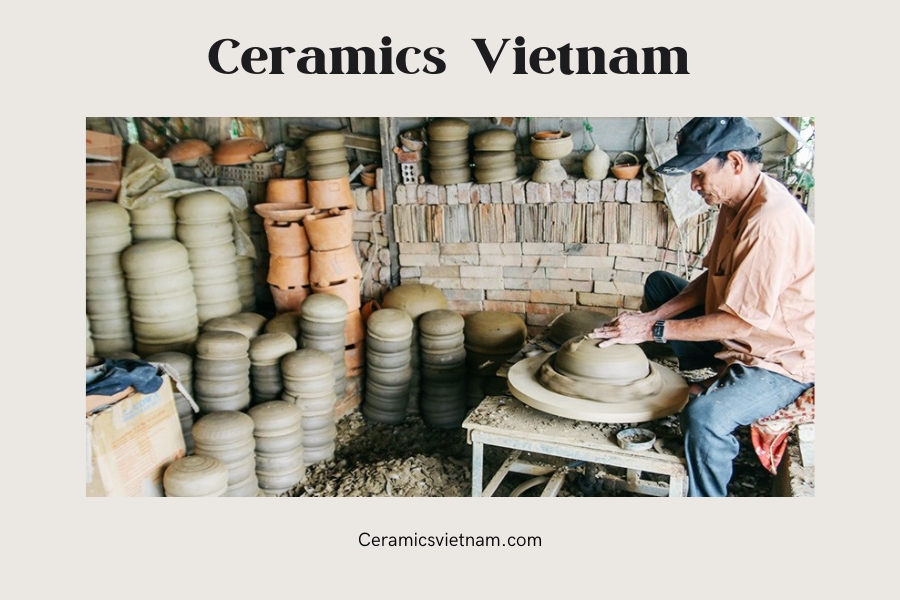
Thanh Ha village (Hoi An, Quang Nam)
There are many different types of traditional wood-fired kilns, each with their own unique characteristics and firing techniques. One of the most common types of traditional kilns is the anagama kiln, which originated in Japan and is characterized by its long, tunnel-like shape. Anagama kilns are fueled by wood, which is loaded into the kiln through a firebox at one end. The heat and smoke from the fire pass through the kiln, creating a unique atmosphere that produces a range of colors and textures in the finished ceramics.
Another type of traditional wood-fired kiln is the groundhog kiln, which was originally used by Native American potters in the southeastern United States. Groundhog kilns are built into the side of a hill or embankment and are partially underground. They are fueled by wood, which is burned in a pit at the front of the kiln. The heat and smoke from the fire rise up through the kiln, creating a unique atmosphere that produces rich colors and textures in the finished ceramics.
Traditional wood-fired kilns are typically fueled by hardwoods such as oak, maple, or hickory, which burn hotter and longer than softwoods like pine or fir. The wood is stacked inside the kiln in a specific pattern, which allows for efficient burning and even heating throughout the kiln. The firing process can take anywhere from several hours to several days, depending on the size and type of kiln, as well as the desired finish of the ceramics.
One of the unique characteristics of traditional wood-fired kilns is the way in which they produce natural ash glazes on the surface of the ceramics. As the wood burns inside the kiln, it produces ash that settles on the surface of the ceramics. This ash melts and fuses with the clay, creating a unique glaze that cannot be replicated by other firing methods. The patterns and colors of the ash glazes are unpredictable and depend on a variety of factors, including the type of wood used, the temperature of the kiln, and the position of the ceramics inside the kiln.
In addition to producing unique and beautiful ceramics, traditional wood-fired kilns are also an important part of cultural heritage and tradition. They are often used by potters and ceramic artists who are committed to preserving traditional methods and techniques, and they play an important role in the promotion and preservation of traditional arts and crafts.
In conclusion, traditional wood-fired kilns are a unique and important part of the history and culture of ceramics. They produce ceramics with a unique character and charm that cannot be replicated by modern kilns, and they continue to be used by potters and ceramic artists around the world. The firing process is time-consuming and unpredictable, but it produces ceramics of unparalleled beauty and quality, making it a valuable part of cultural heritage and tradition.
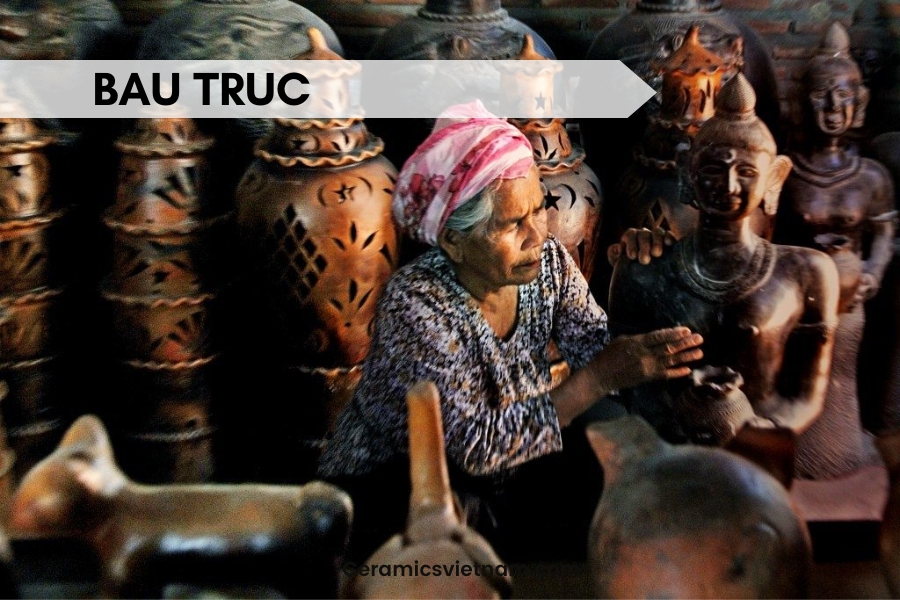
Bàu Trúc: The oldest extant pottery village in Vietnam, and possibly Southeast Asia

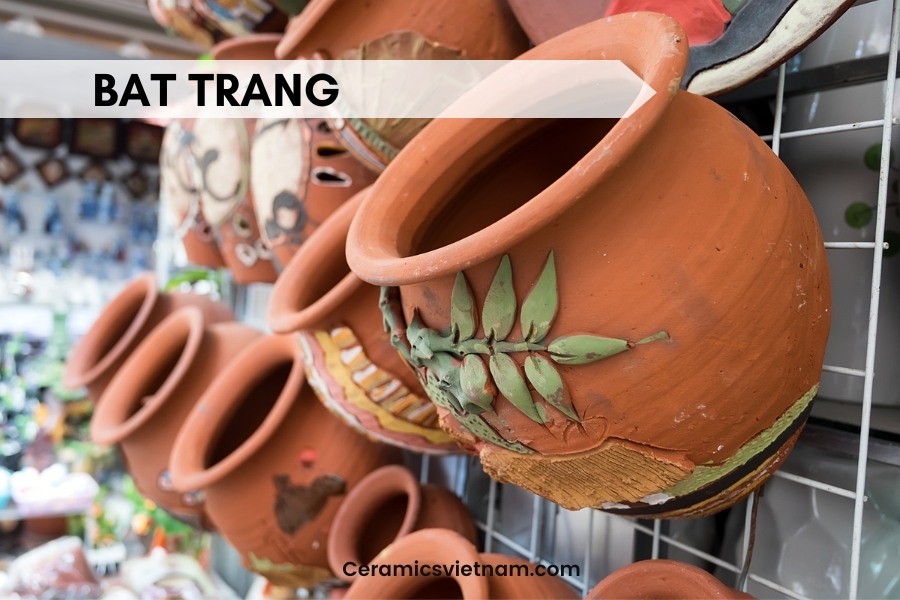












Leave a reply